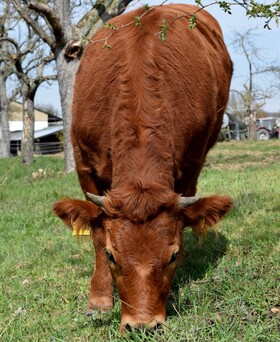


Approximately 30% of the world's ice-free land is currently used for grazing, and an additional 33% is cultivated for fodder. In total, livestock accounts for about 20 % of the total biomass on earth. The accompanying intensive use of grassland in agriculture and the cultivation of feed for livestock in monoculture is causing an increasing loss of biodiversity, deforestation of still intact forests, the release of greenhouse gases and the degradation of the soil ecosystem.
A partial problem: overgrazing
While the causes of soil degradation, and thus the release of not insignificant amounts of CO2, are manifold, overgrazing is a major contributor to this global problem. For example, excessive grazing of plants by too many livestock on a pasture can lead to a degradation of the plant cover and a reduction in soil cover. The soil becomes looser and erodes more quickly. In extreme cases, desertification occurs and with it the loss of CO2-binding grassland.
According to studies, the loss of natural grassland is driven by the intensification of pasture farming as much as by arable farming. The result: according to the UN, a total of 1.5 billion people in 169 countries worldwide are affected by desertification. Every minute, 23 hectares of new desert land are created. It therefore remains to be controlled exactly how much pastures can be stressed by animal impact, that important recovery times for the sustainable preservation of the ecosystem are observed and that the natural balance is thus always managed holistically.
What follows from intensive livestock farming should come as no surprise to many: According to estimates by the FAO (Food and Agriculture Organization of the United Nations), the global share of emissions from the livestock sector accounts for 14.5 % of global greenhouse gas emissions. This estimate includes, among other things, emissions from the intestinal fermentation of ruminants, feed production and land use changes caused by livestock farming, such as slash-and-burn cultivation for pasture and forage.
In Germany, a dairy cow releases an average of 103 kilograms of methane, which is produced during the digestion process. In 2021, methane emissions from ruminants accounted for a proportionate 76 % of methane emissions from the agricultural sector. This was almost entirely due to cattle and dairy cow farming. In 2021, a total of around 36 million tonnes of greenhouse gas emissions, and thus just under 5 % of Germany's total emissions, could be attributed to direct animal husbandry.
Now you might think: Why continue to keep cattle when they account for a not inconsiderable share of greenhouse gas emissions?
However, it is important to consider the way in which cattle are kept. Sustainable grazing by means of holistic pasture management can contribute to climate protection due to the low number of animals and the short time they spend on the pastures. Thus, sustainable grazing has a particularly beneficial effect on maintaining plant diversity and density. The soil thus binds 12-15 % more carbon in organic farming than in conventional livestock farming.
Thanks to ruminants, 4.7 million hectares of grassland in Germany can also be maintained and used productively. As a result, important CO2 sinks are preserved. Despite methane emissions, ruminants thus make an important contribution to climate protection. To what extent the method of holistic pasture management leads to a higher humus content in the soil and thus actively contributes to climate protection remains to be verified. Here, the method of ecological monitoring according to the principles of the Savory Institute can offer an approach. After one year, we have also checked the effects on pasture areas of our cow herd with the help of ecological monitoring. Initial observations indicate increased plant growth and denser soil cover and thus increased storage of CO2 in the soil.